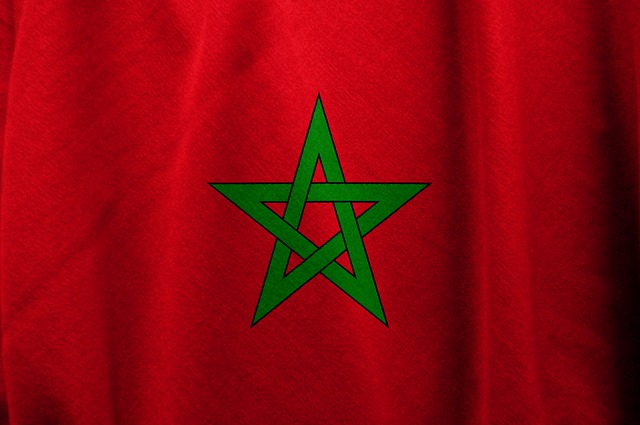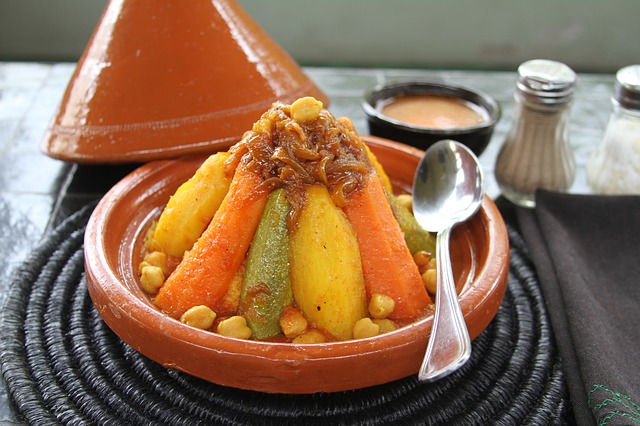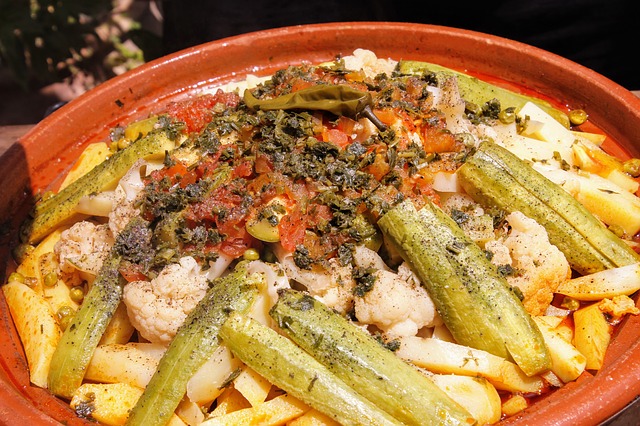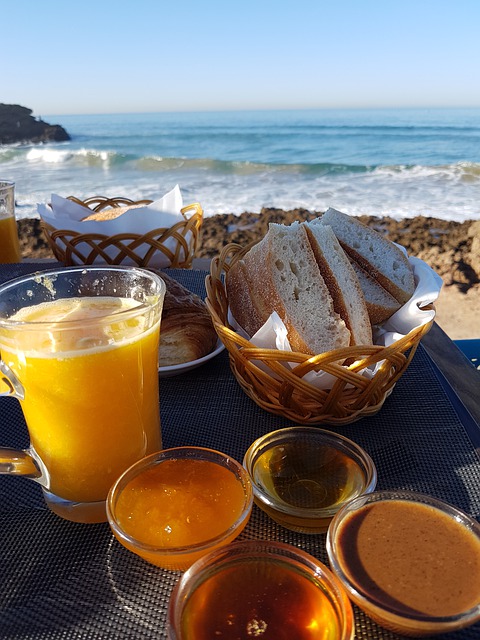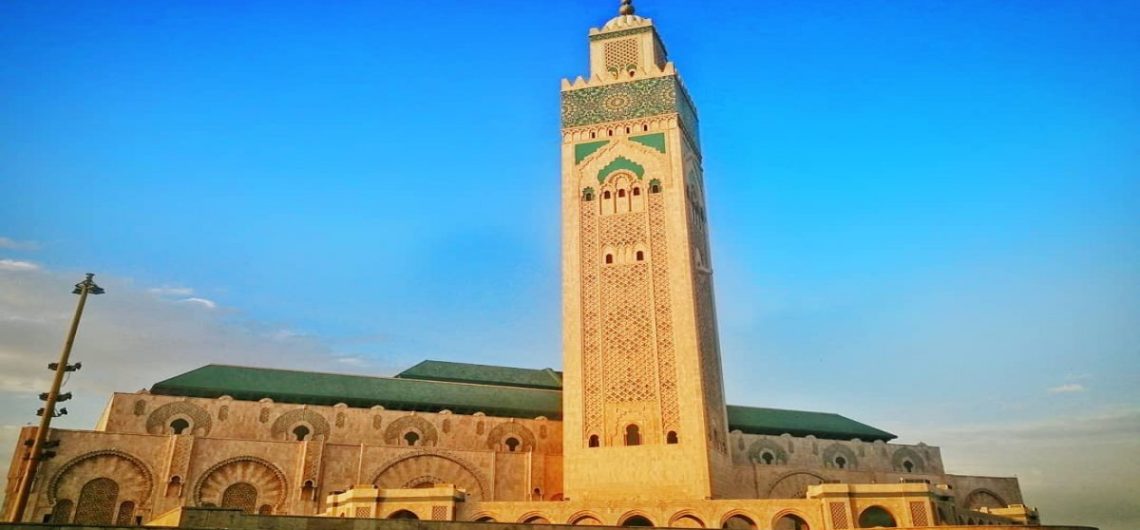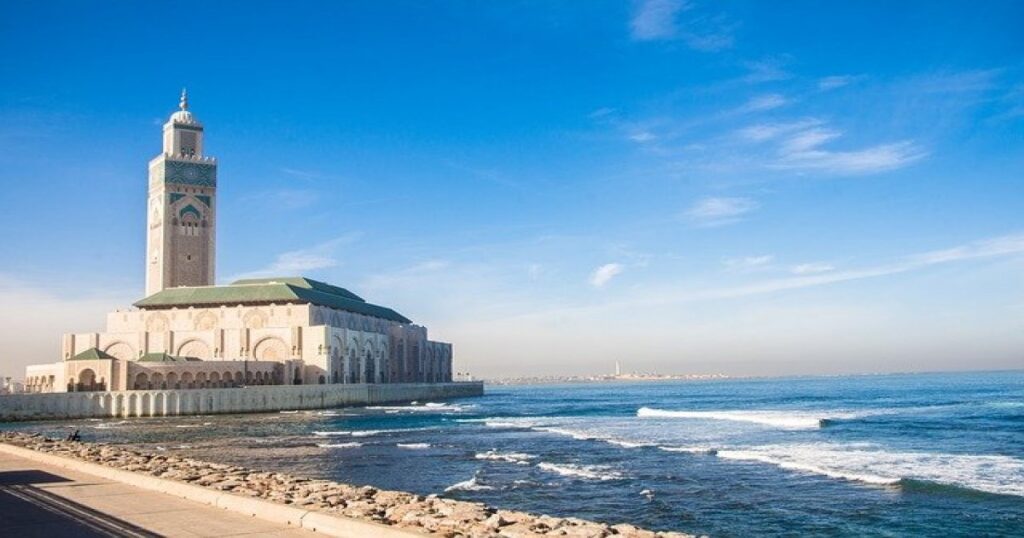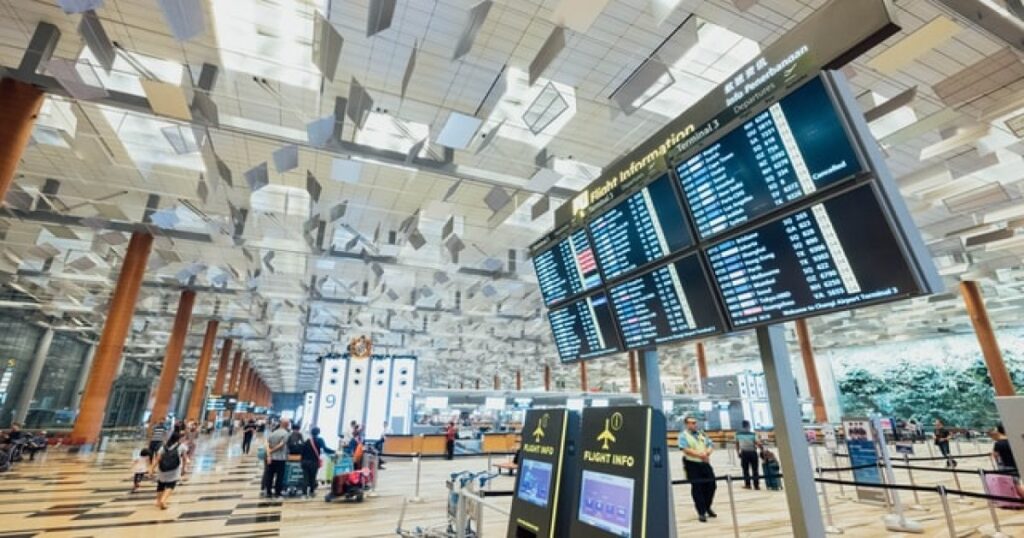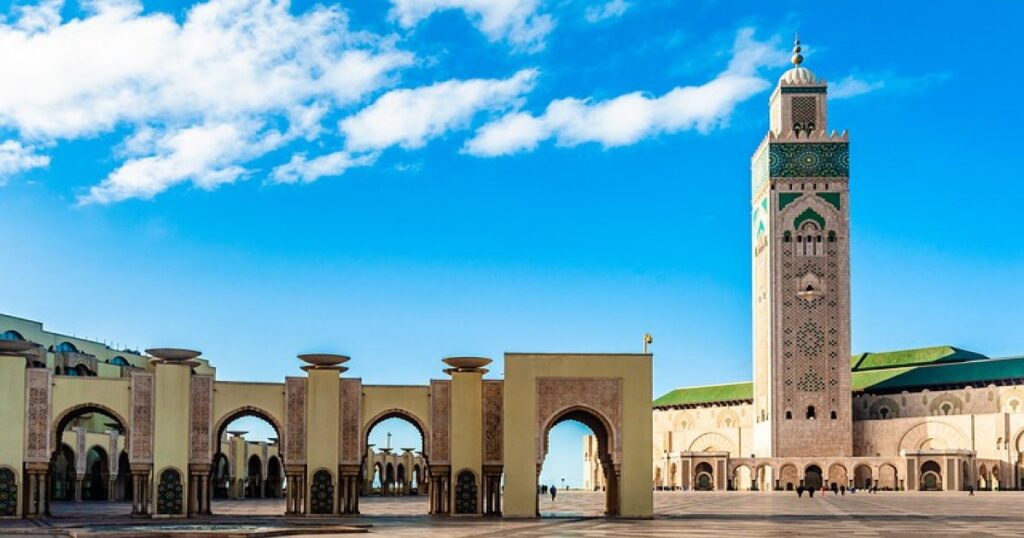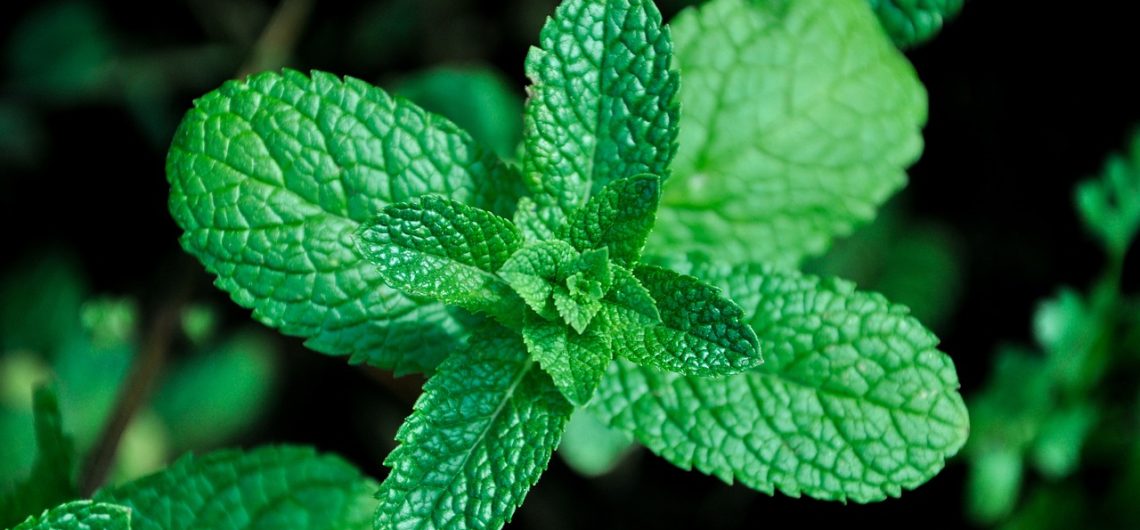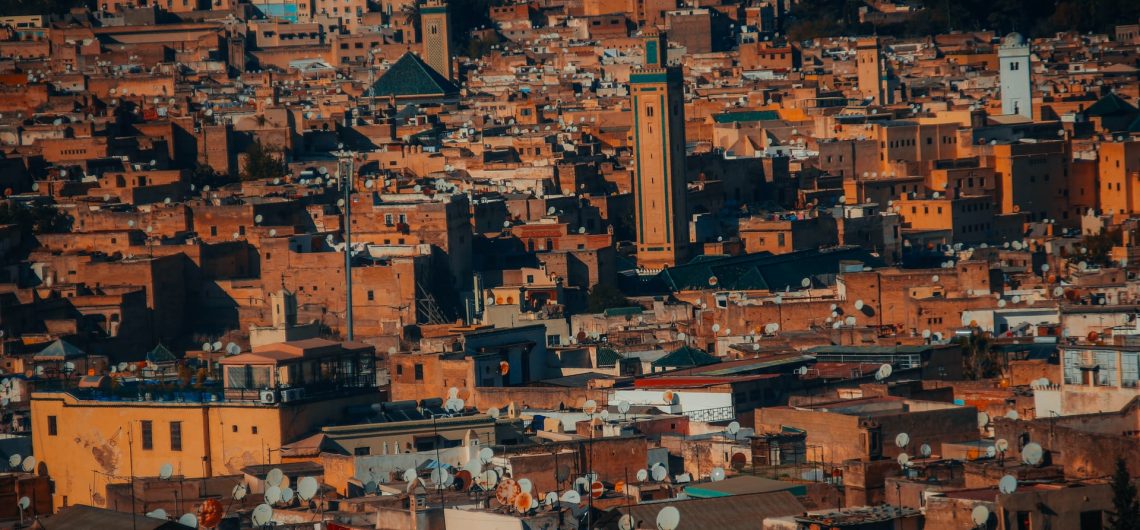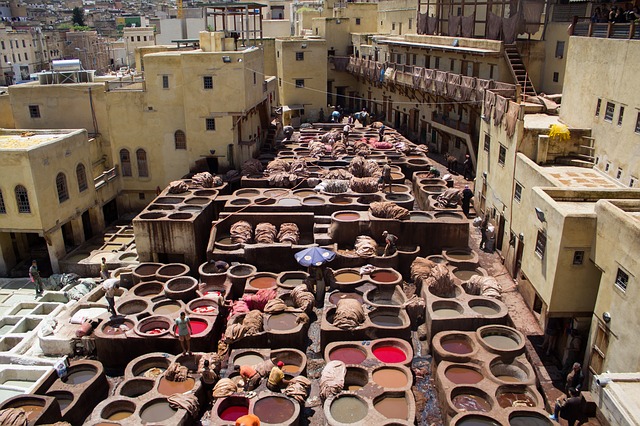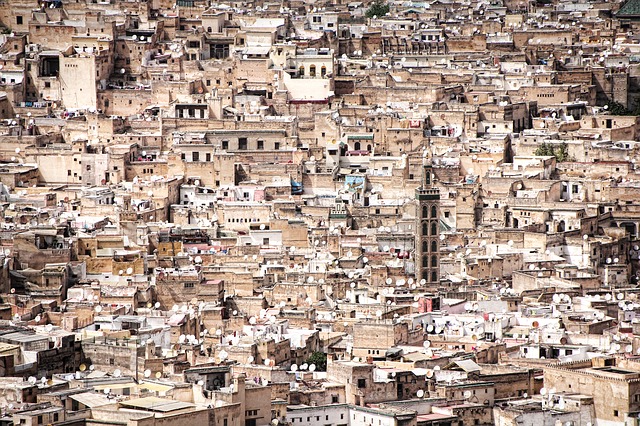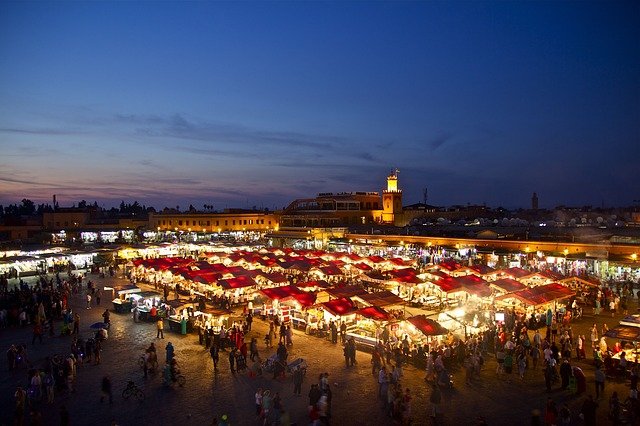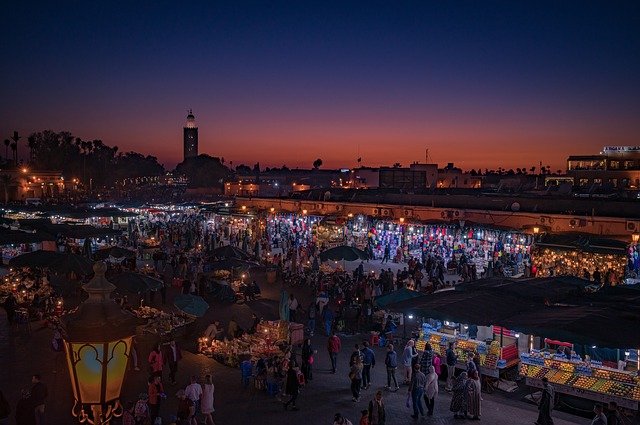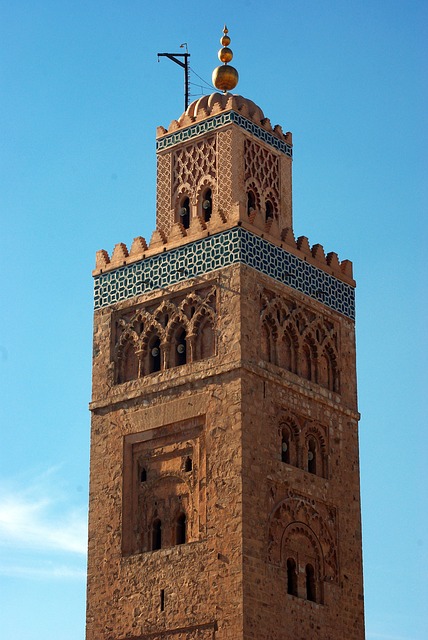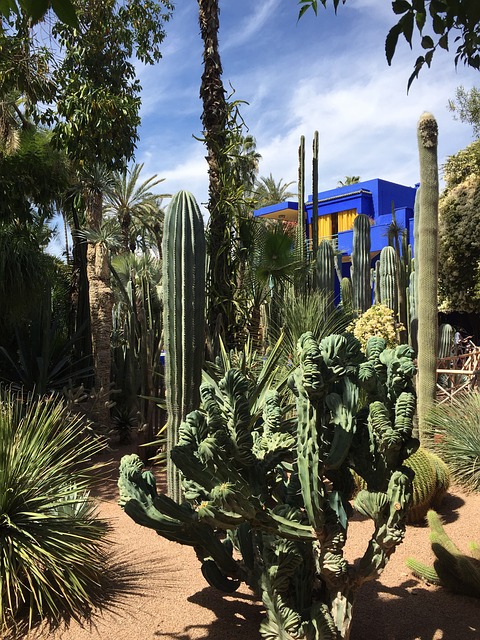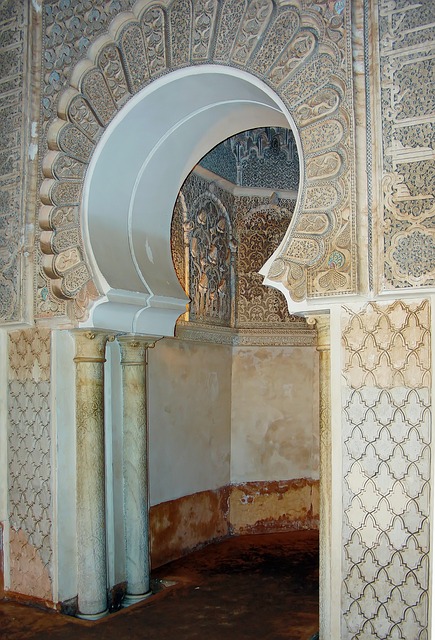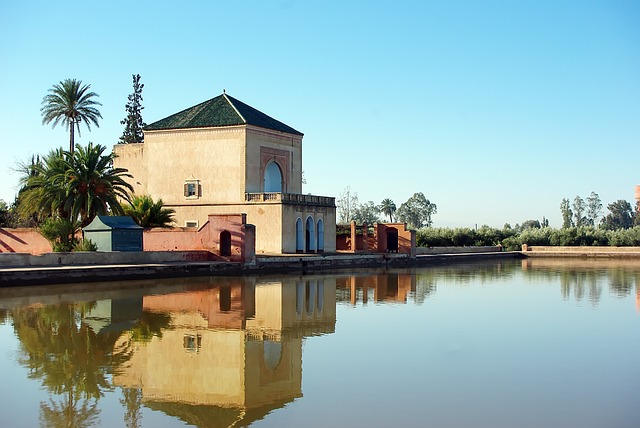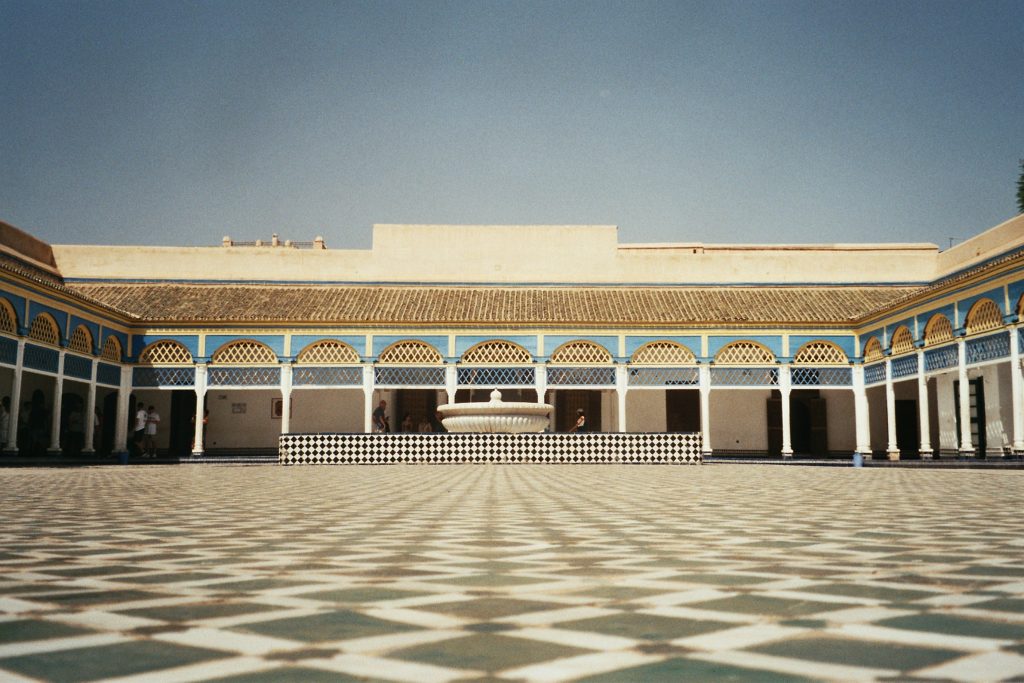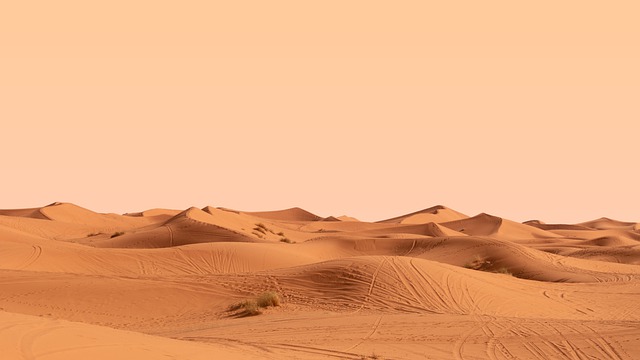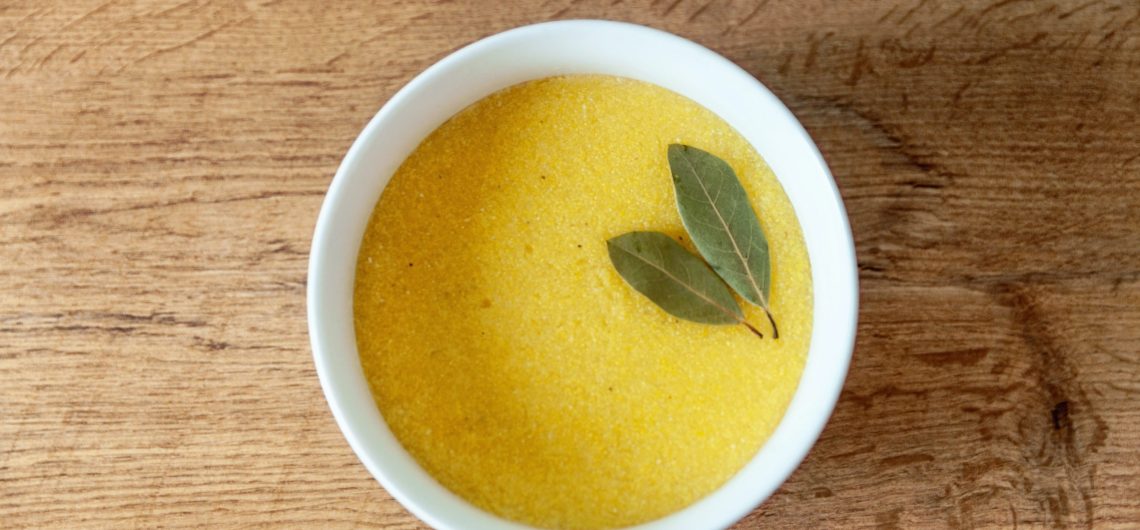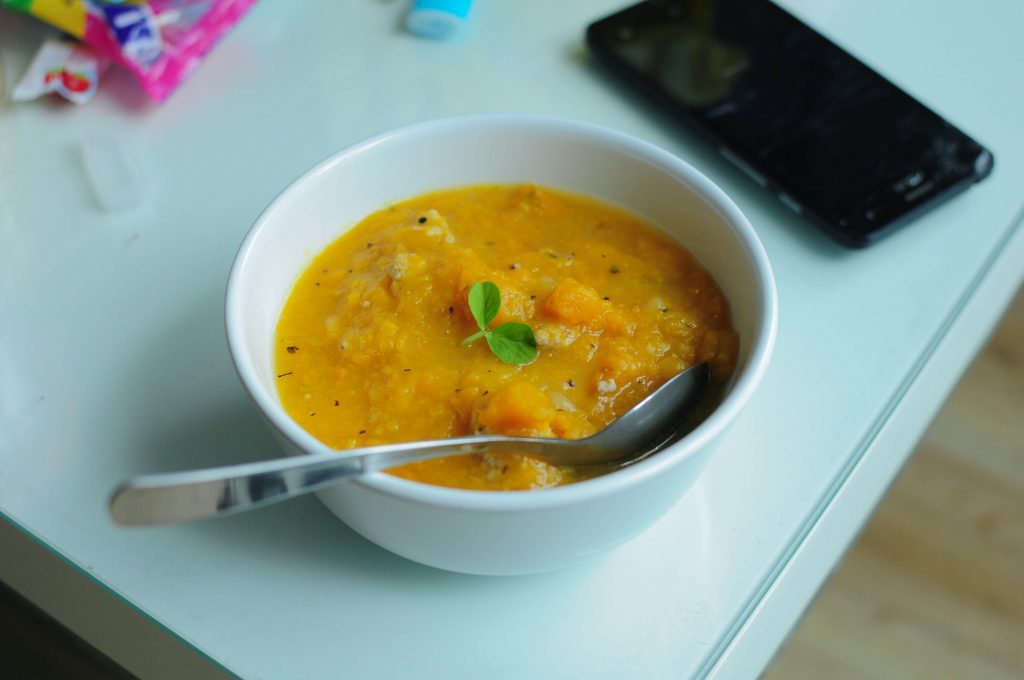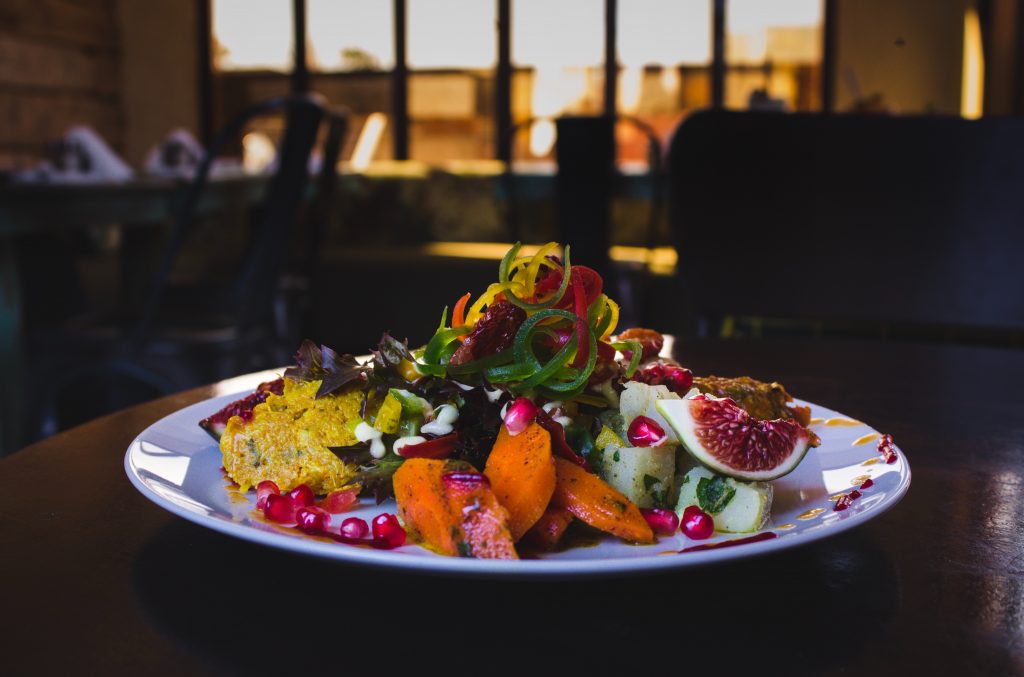Moroccan Cities in General
Holidays in Morocco – who would have thought? What do you know about this country, except that Morocco brings juicy tangerines from here? Buying a tour to Morocco, you will be mesmerized by the beauty and color of this country. It became the home of several cultures: Berber, African, Arabic, Spanish. Walking through the streets, on one side you will see a mosque with a high minaret, on the other – the Catholic Cathedral, on the third – the landscapes of the Western Sahara. This embodiment of cultures and the natural landscape of Moroccan Cities once inspired the designer Yves Saint Laurent to create new masterpieces. Incoming tourists are much more inspired by the beaches of Morocco, which are washed by the waters of the Atlantic Ocean and the Mediterranean Sea.
Morocco is located in Northwest Africa. If you look at the map, the country is next to Spain. Morocco is separated from Europe by the Strait of Gibraltar. The state belongs to the so-called Maghreb countries, or the Arab West. More than 36 million people live in Morocco, of which about 60% are Arabs and 40% are Berbers.
Of course, the historical events in Morocco have left their mark on how the country lives today. In ancient times the territory belonged to Carthage, the Roman Empire, then it was captured by the Vandals and then returned by the Byzantines. In the Middle Ages, Morocco became part of the powerful Arab empire. In the XVII-XVIII centuries, the de facto power in the country belonged to the sea pirates. In the XIX-XX centuries, as a result of the war, some of the land belonged to Spain and some was under the influence of France. It was not until 1956 that Morocco became an independent state. But one historical question remains open: the exact border of Western Sahara is still not defined.
Such global historical events are reflected in the culture of Morocco, the mores and the life of the locals. We encourage you to get to know this colorful country and tell you: “Welcome to Morocco!
Moroccan cities show steady population growth year after year. The capital is not the largest in the country, which is already a difference. But there is a caveat: Rabat is separated from Salé by a river and connected by a bridge. Together they are part of the metropolitan agglomeration of 2.5 million people. Europeans come to Morocco for the exotic, from architecture and landscapes to food, carpets and handicrafts.
The best time to visit Morocco?
To answer the question “When is the best time to vacation in Morocco?”, you need to understand what kind of vacation you are waiting for. High tourist season in Morocco is summer. Here come the lovers of beach holidays. If you want to enjoy plenty of water in the Atlantic, we recommend to come in August and September. Water warms up by this time.
Morocco is considered the snowiest country in Africa, so the ski resort attracts tourists from all over the world. If you want to conquer the Atlas Mountains, come in January and February.
Excursion holidays in Morocco are ideal in the off-season. The weather becomes comfortable for a long stay outside
How to get to Morocco?
By plane, of course. There are no direct flights from Novosibirsk, so you have to change planes in Moscow. There are several airports in Morocco. Tourists from Russia arrive by charter flights at the airport of the most popular resort, Agadir. There are also regular flights from Moscow with connections to Marrakech and Casablanca.
Cities and regions of Morocco
- Main resorts in Morocco
Casablanca
Casablanca means “white house” . Casablanca is a city located in western Morocco on the Atlantic Ocean, the largest port city in the country, which is located near the capital Rabat.
The affluent city of Casablanca was already known in the Middle Ages as Anfa. In the 15th century it was destroyed by the Portuguese, and in the 16th century it was completely rebuilt by them. In 1755, there was an earthquake that destroyed the city again and rebuilt it again.
In 1907 the town was occupied by the French. During their rule the city began to grow and develop rapidly. Modern Casablanca was built around the old city.
During World War II, Casablanca was the main location for the landing of American and British troops. It was also the site of negotiations between Winston Churchill and Franklin Roosevelt.
In 1956, the French left the city due to the independence of Morocco. Casablanca faced economic difficulties. Tourism and a booming industry helped it to prosper.
Casablanca is the leading commercial city in North Africa. The city is linked to the outside world by railroads and highways, as well as by an airline and a large port located in one of the largest artificial harbors in the world. Most of Morocco’s international trade passes through Casablanca.
Exports in Casablanca include leather, wool, cereals and phosphates. The leading industrial branches are fishery, woodworking, furniture production, production of building materials. The tobacco and glass industries are also developed. Almost all banking transactions take place in Casablanca.
The main attraction of Casablanca is located on the Atlantic coast – the Mosque of Hassan the Second. This is the second largest mosque in the Muslim world after the mosque in Mecca. This building was erected by the French architect Michel Pinceau. In addition to its religious purpose, the mosque serves as a cultural center. A library and a national museum are located here.
The design and decor of the mosque are truly admirable. The mosque has a roof that can be removed in three minutes and turn the prayer hall into a terrace. The halls are painted with murals, patterns and Arabic script. The building can hold up to 100,000 people. Hassan the Second Mosque is the most luxurious mosque built in the 20th century.
The bazaars of Casablanca deserve special attention. An entire block of Habbous is devoted to market trading. Narrow blocks and alleys can merge into one market square, which is divided into a confectionery market, an olive market and a pottery market. Nearby are the antique stores, where you can buy very inexpensive items of expensive fabrics, or try a delicious date cake.
Nightlife lovers will enjoy Casablanca’s Corniche neighborhood, with its concentration of beaches, hotels, bars and restaurants.
Casablanca has a beautiful historic building: the Mahakma du Pacha, where the governor of Casablanca, the Pasha, used to receive guests and judge people. This building is now one of the district prefectures: the magnificent decoration of the 64 halls and the wealth of decorative art in the inner courtyards.
Fez
Fez is a Moroccan Cities with a population of approx. Fez is the oldest Moroccan Cities and the largest in northern Africa, located at a distance of 294 km from Casablanca. The city is known for the oldest university in the world – the University of Fez.
Around 789, Idris I. founded a settlement on the eastern shore of the river Fez. 20 years later, on the opposite bank of the river, Idris II. made the founding city the capital of the Idrissid state. In the eleventh century, the Almoravid dynasty united the two cities and from the twelfth century, Fez became the largest city in all of Islam. Under the Berber Marinid dynasty, Fez became the capital of Morocco and many new constructions were built there.
Today Fez consists of 2 parts: Fez el Bali (old) and Fez el Jedid (new). The old part of the city was built during the Middle Ages. There are more than 9 thousand streets and alleys without names. Some of the streets are very narrow that passing them, even touching the shoulders of both walls.
In Fez, there is a mosque Moulay Idris (IX c.), a specially protected shrine, which is not even allowed near animals and non-Muslims, and the Karawin Mosque (IX c.), the largest in northern Africa. There are a total of 800 mosques in Fez.
Holidays in Fez
Fez is one of the oldest imperial Moroccan cities. Fez was founded in the 8th century and became a home to several cultures. Now the Moroccan cities is a concentration of history and sights. The medina of Fez (Fez el Bali) is impressive in its intricacy and scale: 14 gates, 6,000 streets, 200 mosques and 180 hamams. In Fez you have to be prepared to discover literally every step of the way. There is also a majestic royal palace and exquisite gardens. Tours in Fez are good for sightseeing. The city is far from the coast, so it is not a beach resort.
Sightseeing in Fez
- What things to do in Fez?
- Don’t get lost in the streets of the medina
Fez is famous for its heritage. History has given the city two medinas at once. A tour to Fez should not fail to include a walk to both. The medina of Fez (Fez el Bali) is impressive in its intricacy and scale: 14 gates, 6,000 streets, 200 mosques and 180 hamams. It is the largest pedestrian zone in the world. Walking through the narrow streets, you feel the very atmosphere of Morocco. A real medieval world: the old houses and buildings, craft shops, noisy markets and locals on carts with donkeys. The main thing here is not to get lost. Take a guide who will lead you through the medina with ease and stop at the most interesting places. Such three-hour mini-excursion will cost 5 euros and will bring a lot of positive emotions.
Another medina of Fez is Fez Jadid. It is considered new, although it was founded in XIII century. It is surrounded by fortress walls. Walking along the streets, you will see the kasbah Sherard (fortress), the royal palace and the Jewish quarter of Mellah.
Admire the beauty of the royal palace
The royal palace in Fez was built in the 17th century. Today it occupies a huge area of about 80 hectares. In addition to the palace itself there are beautiful gardens, fountains, mosques and the oldest school in Fes.
The palace in Fez was built according to all the architectural canons of those times, so you will find similarities with the palaces of other imperial cities. The interiors are luxuriously decorated. The walls framed with Arabic mosaics, stained glass windows, gilded cedar ceilings, expensive carpets, natural silk fabrics – all details of the interior combine to create an atmosphere of grandeur.
Unfortunately the palace is closed to the public, but it is surrounded by 7 gates, which are a sight in themselves and attract tourists with their beauty.
A glimpse of Al-Qarawin University Mosque
The university was founded in the ninth century. It has produced a number of scholars, philosophers and theologians who have influenced the development of Muslim and world culture. Now, according to UNESCO, the university is considered the oldest active educational institution. The building is built in the architectural traditions of Morocco: the arches, the elaborate carvings and the square minaret of the mosque, towering over the main building. The place is truly beautiful, but, alas, not everyone is allowed inside. You can look at its majesty through the open doors.
Look into the workshops
It is a crime not to visit a workshop in the city of craftsmen! There are many workshops in the old medina. Check out the pottery, where they can make a tagine in 45 seconds. You can also watch the painstaking work of painters who dot their plates. In other workshops mosaic artists hand carve small pieces for future handmade paintings, be it a table, sink, or panel.
See the process of dyeing leather in the famous tannery quarter of Choire
Fez is known as a city of craftsmen, including leatherworkers. There is even an entire quarter where the ancient techniques of leatherworking are preserved. Masters first treat leather by soaking it in lime baths, then in a solution of bird droppings, and after that they rinse it in paint for a long time and finally leave it to dry in the open air. The ingredients for the dye are exclusively natural: henna, turmeric and other useful remedies.
There are usually stores with finished products near the workshops. At the entrance you will be given a sprig of mint to overpower the aroma coming from the workshops. The big advantage of the products is the price. Here you can get a quality product for a very low price.
Shopping at local markets
In the medina of Fez there are several markets where not only tourists but also locals buy products. Here you can feel the atmosphere of the Arab East. The market sells souvenirs, textile and ceramic products, juicy fruit, spices by weight. Learn more about what you can buy in Morocco here.
Do not forget to haggle. Prices can be inflated by 2 to 3 times, so do not hesitate to negotiate with the seller.
Tangier
Tangier, a Moroccan Cities nearly opposite Gibraltar and occupying a dominant position at the western entrance to the Mediterranean Sea; 428,000 inhabitants (1993) . It was originally the site of the ancient Roman port city of Tingis, but the walled city in its present form was built in the Middle Ages by the Moors. It was seized by the Portuguese in the late 15th century and in 1662 was passed to Britain as part of the dowry of Princess Catherine of the Portuguese Braganza dynasty before her marriage to King Charles II of England. Twenty-two years later, Britain ceded the city to the Moroccan Sultan dynasty, which continued to control the port and surrounding area until 1904. The city then remained in Morocco until 1956, when it was handed over to the Sultanate. Then until 1956 (excluding a five-year period during World War II), T. and its environs were designated a Special Zone under international control. In 1956 it was incorporated into the newly independent Kingdom of Morocco. In 1962, T. received the status of “open port” and is now a major commercial, economic, cultural and tourist center.
Holidays in Agadir
Tangier is a beach resort located in northern Morocco. Its specialty is that it is washed by the waters of the Atlantic Ocean and the Mediterranean Sea at the same time. Tangier landscapes combine beautiful beaches, cliffs, majestic mountain ranges and picturesque bays. Here is a real miracle of nature – the Pillars of Hercules. According to Greek myths, the rocks were created by Hercules. In addition to the natural beauty of the medina Tangier tourists explore the historical monuments, trade in the local markets and take pictures against the backdrop of picturesque houses. Holidays in Tangier is suitable for lovers of beach and sightseeing holidays.
How to get to Tangier?
There are no direct flights from Novosibirsk to Morocco. The tours to Tangier are made with a connection in Moscow: take a direct flight to Casablanca, then drive to Tangier. The distance between the resorts is 340 kilometers. From Casablanca to Tangier you can take a train.
You can also take a ferry that runs from Spain. The distance is only 16 km. But you need a multiple Schengen visa for that.
Sightseeing in Tangier
- What things to do in Tangier?
- Take a photo at the Hercules Caves
The main natural attraction of Tangier. According to legends, Hercules, before his eleventh feat in which he had to steal the golden apples from the garden of the Hesperides, decided to rest and gain strength here. The grottoes have now become one of the attractions of Morocco. The entrance to the cave has two sides – from the ocean and land. And what is surprising is that the opening of the sea outlet resembles the silhouette of the African continent.
For tourists in the cave created a comfortable environment. The caves are clean and dry, working lighting. There is also an observation deck. Admission costs 5 dirhams.
Walk in the medina of Tangier
If you buy a tour to Tangier be sure to visit the medina, the heart of the city. The old city is an Arab quarter with a lot of intricate streets and a fairly dense building. Walking around the medina, you will see a lot of mosques, old houses, luxurious palaces and of course a big bazaar. Here you can buy souvenirs and gifts that will remind you of the atmosphere of Morocco: spices, carpets, natural cosmetics, textiles, lamps, etc. Visitors at the bazaar are entertained by the traders themselves, snake charmers and entertainers.
Climb up to the observation deck of the kasbah
Take part in the Azilaha Beach Festival
The grandiose historical attraction of the medina is the kasbah (fortress). It was built by the Portuguese during the colonization period in the 18th century. By the way, according to historians, the foundations were laid during the Roman Empire. The fortress offers stunning panoramic views of the old town, the sea and the Spanish mountains. The observation decks are open to visitors.
Visit the Sultan’s Palace
The Sultan’s Palace is located on the territory of the kasbah (fortress). The palace was built in the 17th century and belonged to Sultan Dar al-Mahzen. Today, in its luxurious spacious halls are the Museum of Moroccan Art and the Museum of Archaeological Antiquities. In the first one, visitors can see works of art from all over Morocco; in the second – archaeological finds. The palace is surrounded by beautiful gardens, decorated in the Moroccan-Andalusian style.
Unlike other beaches Azilaha is notable because it is not only a natural attraction, but also a historical one. There are ruins of fortress walls and bastions built by the Portuguese during colonization in the 15th century. In summer, the beach turns into an open-air theater – festivals, cultural performances, musical performances are held here.
Touch the 800-year-old tree
n the north of Tangier is the picturesque Mendoubia Garden, a green island where you can see sprawling trees, exotic flowers and unusual plants. Tourists, of course, are attracted by the mighty, incredible-sized dragon tree. According to the locals, its age is 800 years.
Tangier Beaches
Despite the fact that Tangier is famous for its beaches, we recommend not using the city beaches. It is very crowded, noisy and not very clean. But to the west of Tangier there are beaches that are more peaceful.
Marrakech
Marrakech A city in southwestern Morocco, in the foothills of the High Atlas. Founded around 1070 (according to other sources, in 1060 or 1062) by the Almoravids. In the XI-XVII centuries, capital of Morocco. It is a medieval city surrounded by walls with rectangular towers and gates, including the Medina (the old town), the Casbah (fortress) and the Agvedal Gardens with pavilions and pools. Monuments of the medina: Qubba al-Baruddin (domed pavilion, decorated with carvings of stone and stucco, – part of the palace of the unparished Almoravid, first half of the XII century.) Mosques – Qutubiya (concrete, stone, brick, XII century. Kutubiya (concrete, stone, brick, 12th century.); 17 transverse and one longitudinal nave, domes with stalactites, artesonado) with minaret (stone, 1184-99), Ben Salih with minaret (1331), Bab Dukkala (1557; 7 naves); Ben Youssef Madrassah (1565; 8 courtyards, stone carvings, stukkas, painted tiles – zilliji), Zawiya Sidi bel Abbas as-Sabti (16th century cult ensemble, 1184-99, the walls of the mosque were decorated with stone tiles), Zawiya Sidi Bel Abbas as-Sabti (16 naves). , carved stucco); the palace of Bahia (1894-1900; garden). Kasbah monuments: Bab-Agvenau (gate; 12th century, carved stone decoration), mosque (1197), necropolis with sepulchres from second half of 16th century, palaces – Badi (1578-93; in ruins) and Dar el-Makhzen (late 19th century; garden). The modern city was founded in 1913 to the west of the medina. Marrakesh is an old center of carpet-weaving, stone articles, etc. Museums: Museum of Moroccan Art (in the palace of Dar Said, late 19th century.), Museum of Treasures and Ceramics. Ruins of the Tasgimut Fortress (12th century), 30 km south-east of Marrakech.
Holidays in Marrakech
Marrakech is one of the imperial cities of Morocco. Marrakech is famous for its gardens, mosques and ancient buildings of Arab-African architecture. If you buy a tour to Marrakech, you will surely remember the fairy tales of Scheherazade. Majestic palaces, gardens buried in verdure, markets full of colorful products, the atmosphere of the East – this is what to come here for. Marrakech is suitable for excursions. The city is far from the coast, so it is not a beach resort.
How to get to Marrakech
- There are no direct flights from Novosibirsk to Morocco. Tourists from Siberia get to Morocco with a connection in Moscow.
- There are several ways to travel from Moscow to Marrakech.
- You can take a direct flight to Marrakech from Moscow.
- Take a direct flight to Agadir, then drive to Marrakech. The distance between the resorts is 250 km. You can take a bus, rent a car or pre-book a transfer.
- Take a direct flight to Casablanca, then drive to Marrakech. The distance between the resorts is 240 km. You can take a bus, rent a car or pre-book a transfer.
Marrakech Attractions
Marrakech is a Moroccan Cities hardly a vacation destination in the sense that you will be here for the entire trip. Yes, it is a very beautiful city where you can experience a culture shock. You will be struck by the flavor of the place: majestic palaces, gardens buried in verdure, markets abounding with colorful merchandise, mosques, ancient buildings. To visit the sights is enough to go to Marrakech for 1-3 days from the resort, where you are staying.
What to do in Marrakech?
Walk around the medina
The heart of Marrakech is undoubtedly the medina. If you buy a tour to Marrakech, be sure to walk here. The old city is an Arab quarter with a lot of intricate streets and fairly dense construction. Along the perimeter of the medina are situated 9-meter high fortress walls, which were built for protection from enemies about 1000 years ago. By the way, the medina itself was included in the list of cultural heritage of UNESCO in 1985.
Walking around the old city, you will notice that most of the buildings are covered with red clay. This is why the medina of Marrakech is called the Red City. This is the reason why the medina is called the Red City in Marrakech. Life goes on here day and night! Artisans make souvenirs, traders shout over each other to lure tourists, and snake charmers wait for their audience. The center and magnet of the medina is Jem el-Fna Square.
Find yourself in an oriental fairy tale in Djema el-Fna Square
The main square in Marrakech, which attracts tourists with its atmosphere. The square is considered partly a historical site and also a UNESCO Intangible Cultural Heritage site. It is called the “square of beheadings” because criminals and thieves were executed here in the 10th century, sometimes up to 50 people a day. Their heads were hung on the gates.
The terrible past contrasts with the happy present. Now Jem el-Fna square is the busiest place in the city. By day vendors sell souvenirs and in the evening the square is transformed into an open-air theater: snake tamers, artists, unusual dancers, sword swallowers, acrobats, scorpion fights and much more. It feels like you’re immersed in an Oriental fairy tale. You can also have a tasty and inexpensive snack here – the site turns into a huge food court.
Tourists say that the place is quite peculiar. On the one hand, the barkers are a bit tense, but the overall atmosphere of the place is unique in itself, which is what attracts the square.
Catching inspiration in the Majorelle Garden
The garden is located in Marrakech. In the first half of the twentieth century, this garden was the studio of the artist Jacques Majorelle. In addition to painting, the artist was fond of collecting plants, so from his trips he brought curiosities, such as North American and Mexican cacti and Asian lotuses. To contrast with the greenery, Jacques Majorelle painted the walls of the villas and pergolas in bright blue and the details in lemon. Subsequently, this color pairing became a trademark of the park. After the death of the artist, the garden was abandoned, and then it was bought by the famous French couturier Yves Saint Laurent and his friend Pierre Bergé. They put the house in order. Now tourists can admire the fabulous scenery, contemplate the nature, take pictures against the bright blue walls and admire the private collections of Yves Saint Laurent. The garden looks like a corner of paradise, but beware, it is very small – if you want you can walk around it in 20 minutes. The ticket price to the Majorelle Garden is 70 dirhams, to the museum 30 dirhams.
In the medina of Marrakech there are several markets where not only tourists but also locals buy products. Here you can feel the atmosphere of the Arab East. The market sells souvenirs, textiles and pottery, juicy fruit, spices by weight. Learn more about what you can buy in Morocco here.
Do not forget to haggle. Prices can be inflated by 2 to 3 times, so do not hesitate to negotiate with the seller.
Visit bahia palace
The palace, which attracts crowds of tourists, was built by Bou Ahmed Sidi Moussa, Grand Vizier of the rulers of Moulay Hasan and Moulay Abd al-Aziz, for one of the four wives of the harem. In the process of creation, the area expanded to eight hectares. At one time, four wives and 24 concubines lived here. As it was meant to be, the palace was luxuriously decorated, and the materials for decoration were brought in from all over Morocco. The cedar doors, painted ceilings, skilled stone carving, traditional mosaic – all details of the interior combine to create an atmosphere of grandeur. The adjoining territory is also well-groomed: cozy courtyards are buried in verdure. By the way, after the palace was built the Vizier was envied by the Sultan himself, as the harem became the most beautiful in Morocco. Visit the palace and you will understand why.
While vacationing in Marrakech, stay in one of the hotels decorated in the local style. Often the hotels are in traditional Maghreb houses with patios and gardens. You can find such accommodations with any budget, as the stardom of the hotels varies. “Three” is suitable for unpretentious tourists, and the luxury “five” – for those who are important for comfort and level of service.
Also in Marrakech is located the most beautiful hotel in Morocco, La Mamounia. It resembles a real palace of the orient. Its status is confirmed by the fact that members of the royal family stay here.
For tourists with an average budget, we recommend to take a closer look at the “four”, such as Riad Mogador Kasbah, Golden Tulip Rawabi.
Managers of the travel agency “Liberty Travel” will help you choose a tour to Marrakech and select the best hotels in Marrakech in accordance with your wishes.
Agadir
A popular beach resort in Morocco. Agadir’s beaches are lined with golden sand and washed by the waters of the Atlantic Ocean. The coastline stretches for nearly 6 kilometers. Hotels in Agadir are presented to suit all tastes and budgets: there are luxury “five” with thalassotherapy centers, and simple “three” for unpretentious tourists. There are many Europeans here, so the service is quite high. Most hotels are located on the second coastline. The resort is suitable not only for fans of lazy beach holidays, but also for surfers who want to catch a wave.
Holidays in Agadir
Agadir is a Moroccan Cities popular beach resort in Morocco. The beaches of Agadir are covered with golden sand and washed by the waters of the Atlantic Ocean. The coastline stretches for about 6 kilometers. Hotels in Agadir are presented to suit all tastes and budgets: there is a luxury five with thalassotherapy centers, and a simple three for unpretentious tourists. There are a lot of Europeans, so the service is on a fairly high level. Most hotels are located on the second coastline. The resort is suitable not only for fans of lazy beach holidays, but also for surfers who want to catch a wave.
Attractions in agadir
The main attraction of Agadir are the beaches, so most of the entertainment is outside the resort. If you want to experience the culture and history of the country, you have a great opportunity – you can buy a tour of the south of Morocco, the starting point of which is Agadir.
If you don’t feel like going anywhere, enjoy the beaches, the ocean waves, windsurf, walk around Agadir, go clubbing, try the freshest seafood, go horseback riding, play golf, and relax in a thalassotherapy session.
What to do in Agadir?
Take a walk in the Moroccan cities
Agadir does not have the old city that tourists go to Fez or Marrakech for. But there is something to see here as well. In the city center you can walk through the boulevards and avenues, as well as look at the park “The Valley of Birds”. It is a small zoo with mostly birds: pink flamingos, swans, peacocks and parrots. You can also relax on the benches in the shade of trees. There is a sandbox for kids to play in. Entrance to the park is free.
Also in the center of the city is the Lubnan Mosque (Lebanon). Despite the fact that it was rebuilt after an earthquake in 1960, it looks quite traditional. The mosque is very beautiful and is the pride of the locals. Its high minaret is decorated with ceramic mosaic. You can admire the building only from outside, as the mosque is closed to foreigners.
The Souk el-Had city market is a shopaholic’s paradise. The main thing is not to get lost in the 6,000 shops. The market is very large and is considered the third largest in Africa. Here you can buy souvenirs for yourself and your loved ones: pottery, textiles, leather goods, spices, etc. Do not forget to haggle.
If you want to see the marina and the most beautiful area of Agadir, go to the Marina. This area is located at the foot of the famous mountain of Agadir on which is written “God, King, Fatherland”. The development of the area began in 2007. The “chip” of the Marina are the houses, which are arranged in such a way that directly to the entrance to them can be approached by boat.
Tourists are beckoned by the photo background of the Marina: blue sky, blue sea, hundreds of ships and coastal wind. There are also shops and cafes where you can enjoy fresh seafood.
In the evening, go back to the ocean, or rather to the waterfront. Locals and tourists walk around and enjoy the view. If you want a spectacular sunset, go to the Ferris wheel, which is located on the waterfront.
Catch a wave
Agadir’s coastline attracts water sports enthusiasts. The ocean waves create great conditions for surfers. If you have long wanted to try it, then do it by all means. You can try to get up on water skis, surf or practice windsurfing.
Dance till you drop at discos
In the clubs of Agadir, you can dance in the bright lights. For a fun night out, start your stroll on Boulevard du 20 Aout, where the cafes, bars and clubs are concentrated. One of the most famous clubs in Agadir is also on this street, L’Actors’ (Royal Atlas Hotel). The club, with its large dance floor and crystal chandeliers, hosts parties with the most fashionable DJs.
Most of the clubs are part of large hotels.
Parties usually start around 00:30 at night.
Prepare to pay about 100 Moroccan dirhams for admission. The average price of an alcoholic drink in a club is 130 dirhams.
See crocodiles
While vacationing in Agadir is worth a visit to the crocodile farm. This entertainment will please both adults and children. The farm itself is completely stylized themed, even the entrance is made in the form of the mouth of an alligator. There are about 300 crocodiles living here. It is hard to imagine! On summer days, tourists admire these beauties sunbathing. If you want to see the feeding of crocodiles, it is held at 12:00, 15:00, 17:00 and 19:00. There is also a crocodile research lab where you can come in and see the exhibits. The final part of the park is the cactus garden with giant plants, turtles and curious iguanas. It totally feels like you’re in the desert. It takes about 2-3 hours to visit the park.
Relax with a thalassotherapy treatment
Thalassotherapy is procedures for recovery using sea water, seaweed, and sea elements. Morocco offers a variety of thalassotherapy programmes: facial and body care, recovery after childbirth, post-operative and post-traumatic courses, general recovery procedures, courses for improving blood circulation, etc.
Morocco is the right country to undergo thalassotherapy for at least three reasons. Firstly, after the colonial domination European technologies are still in place. Secondly, these European technologies cost many times less than in Europe itself. By the way, celebrities from different continents come here for recovery. Thirdly, all the ingredients for procedures are the freshest. Sea air adds to the benefits of the procedures.
There are a great variety of procedures, but note that the effect is much better, if you undergo the course. The most popular procedures are: hammam + gommage (using sea clay) + wraps, massage under the drip shower, algotherapy (treatment with seaweed), underwater shower, lymph drainage.
Beshes in Agadir
Sandy beaches are what most tourists come to Agadir for. Agadir’s sandy beaches are washed by the Atlantic Ocean. Do not expect the water to be as warm as the Mediterranean Sea. The average temperature of the ocean water in summer is +21 degrees. For the most part, the entrance to the ocean is smooth, which is also great for holidays with children.
The coastline of Agadir stretches for 10 kilometers, so there is enough room for everyone. The best beaches in Morocco are located in the northern part of the city, between Agadir and Essaouira: Tamounza (12 km from Agadir), Imouran (17 km), the famous Tagazou (20 km), Timzgida (23 km) and Agroud (30 km).
Tagazou beach is a paradise for surfers and photographers. The former love it for the good waves, the latter for the rocks that surround the beach and create a beautiful backdrop for photo shoots.
On the beaches of Agadir, everyone can do what he or she likes: children splashing next to the beach, parents sunbathing, lovers of water sports: surfing, sailing, kite surfing and paragliding. The ocean makes for ideal conditions for such activities in the central and southern part of Agadir. Cool waves and reefs can be found at Anchor, Banana, Imsuan Bay, Devils Rock, Cro Cro-Cro, Hash and Killer.
Along the coastline in Agadir is a promenade with stores, restaurants and cafes. Here you can walk in the summer evenings and enjoy the sunset.
Managers of travel agency “Liberty Travel” will help you find a tour to Agadir and choose the best hotels in Agadir.
Meknes
One of the three imperial Moroccan cities. The city is not popular among tourists, as it is not a beach resort. Mostly come to Meknes with a tour. If you have time and want to feel the atmosphere of the Arab East, then go here. Meknes conditionally divided into two parts: in the medina concentrated historical monuments – palaces, mausoleums, ancient buildings, and in the new part of town – cafes, restaurants, souvenir shops. Meknes also attracts tourists with a very luxurious pastime – here you can play golf in the royal gardens. Near Meknes there are also famous Roman ruins of Volubilis, which are included in the list of cultural heritage of UNESCO.
Meknes is one of the three imperial cities of Morocco. The city is not popular among tourists because it is not a beach resort. Mostly come to Meknes with a tour. If you have time and want to feel the atmosphere of the Arab East, go here. Meknes conditionally divided into two parts: in the medina concentrated historical monuments – palaces, mausoleums, ancient buildings, and in the new part of town – cafes, restaurants, souvenir shops. Meknes also attracts tourists with a very luxurious pastime – here you can play golf in the royal gardens. Near Meknes there are also famous Roman ruins of Volubilis, which are included in the list of cultural heritage of UNESCO.
How to get to Meknes
There are no direct flights from Novosibirsk to Morocco. Tourists from Siberia get to Morocco with a connection in Moscow.
By direct flight to Casablanca, then go to Meknes. The distance between the resorts is 240 kilometers. You can get there by bus, rent a car or pre-book a transfer.
Also from Casablanca and other resorts in Morocco you can get to Meknes by train.
Meknes atrraction
Tours to Meknes are not popular with tourists because there are fewer hotels. It is quieter than other resorts, and you can enjoy the beauty of historical monuments. To visit the sights enough to go to Meknes for 1-2 days along with a tour.
What to do in Meknes?
- Take a walk in the medina
Of course, the heart of Meknes is the medina. The main attractions are located here. If you buy a tour to Meknes, be sure to walk through the medina. The old town is an Arab quarter with a lot of intricate streets and fairly dense housing. Along the perimeter of the medina are 10-meter stone walls with corner towers, which were built to protect against Berber raids. You can enter the medina through the Bab el-Mansour Gate. The beautiful gate with its mosaic patterns and fine stucco work is already a tourist attraction. They were built in the 18th century and are still considered the most beautiful gates in Morocco.
Walking around the old city, you will notice that the city has preserved many historical sites. Meknes was once the capital of the powerful Sultan Moulay Ismail. During his reign, many palaces, gardens, and mosques were built. In fact, the large number of mosques contributed to the fact that Meknes is called the “city of a thousand minarets. Recall that non-Muslims are forbidden to enter the mosques, but you can admire the exterior. The most popular mosque in Meknes is the Great Mosque with its majestic carved doors. Not far from the mosque is the Madrasa Bu Inania. It is built in an airy Spanish-Moorish style and is a landmark.
The medina is also home to famous palaces. Dar Jamai Palace was built in the late 19th century in the best Moorish traditions. The building is decorated with mosaic and tile tiles and festooned arches. Next to the palace there is a beautiful garden with cypress and orange trees. Nowadays in the palace there is an ethnographic museum. Visitors can get acquainted with the elements of everyday life, a rich collection of embossing, antique jewelry. Another palace, El Mansour, has become a popular tourist store.
Another of the attractions of Meknes located in the medina is the medieval building complex Kheri es-Suani. It combines stables, grain storage facilities, and an Agdal pond. These stables once housed more than 12,000 horses and the wheels of the waterworks were turned by slaves. After a full day’s sightseeing, you can pause and admire the water of the Agdal Pond.
The center and the magnet of the medina is El Khedim Square. During the day, vendors sell souvenirs, and in the evening the area is transformed into an open-air theater: snake tamers, artists, dancers performing unusual dances, acrobats, fire swallowers and much more. The feeling of plunging into an oriental fairy tale. You can also eat tasty and inexpensive food here – the site turns into a huge food court.
Visit the famous ruins of Volubilis
Even if you are skeptical about archaeological sites, Volubilis is worth a visit. It is an island of antiquity in Africa. The city was founded in the 3rd century B.C. and later, in the 1st century A.D., became part of the Roman Empire. Volubilis was built up according to a regular plan, and water was supplied to the locals by an aqueduct. The city prospered thanks to the grain and oil trade. After the Arab conquest (7th century) and the earthquake (18th century) Volubilis gradually fell into decline.
Volubilis is located 30 kilometers from Meknes. Although most of the Roman architecture, dating back to the third century, has been lost, there are still columns, a basilica, a triumphal arch and about 30 high-quality mosaics. Speaking of mosaics: they are really impressive. Painstaking handiwork, which has survived several centuries, now delights historians and tourists. The most beautiful and famous are the mosaic of the 12 deeds of Hercules and the mosaic of the Four Seasons.
Prepare a traditional dish
Meknes has probably the largest concentration of catering establishments in all of Morocco. Here you can taste a variety of dishes at fairly democratic prices. If you want to immerse yourself in Moroccan culture and understand why it tastes so good, we recommend enrolling in a master class at the Taste of Morocco cooking school. Under the guidance of a chef you will cook delicious dishes. The cost of the master class is 450 Moroccan dirhams per person.
Shop at local markets
There are several markets in the medina of Meknes. Here you can feel the atmosphere of the Arab East. The market sells souvenirs, textile and ceramic products, embossed jewelry, spices by weight. Learn more about what you can buy in Morocco here. Prices here are slightly lower than in neighboring Fez, however, keep in mind that the deeper you go into the market, the cheaper the goods get.
Also, the prices can be overstated by a factor of 2 or 3, so do not hesitate to haggle with the seller.
Rabat
The capital of Moroccan Cities. The city is located on the Atlantic Ocean. Rabat is suitable for excursions. There are many attractions: the old medina, the fortress Kasbah Udaja, Hassan Minaret, the royal palace. Most Russian tourists come to Rabat for a few days of excursions.
El Jadida
Holidays in El Jadida
El Jadida is a port city located on the shores of the Atlantic Ocean. It is located 90 km from Casablanca. Tours in El Jadida are attractive because of the coast: the beaches are covered with golden sand, and the ocean waters are quiet and calm here. The visiting card of El Jadida is an ancient citadel, which is a UNESCO World Heritage Site. Also perfectly preserved four bastions, once guarding the town. El Jadida is suitable for beach and sightseeing holidays. You can also enjoy a variety of activities such as golfing, horseback riding, sea cruises or wine tasting.
How to reach El Jadida?
There are no direct flights from Novosibirsk to Morocco. Tourists from Siberia get to Morocco with a connection in Moscow: you can get to Casablanca by direct flight and then take a train to El Jadida. The distance between the resorts is 106 kilometers.
You can also get to El Jadida via Agadir or Rabat.
Atrraction in El jadida
- What to do in El Jadida?
The main attraction of El Jadida are the beaches. In fact, people come here just for them. However, the resort represents some interesting historical monuments, and the local architecture is unique as it has embodied the African, Eastern and European traditions.
Visit the El Jadida Citadel
The historic citadel, which is a UNESCO World Heritage Site, is El Jadida’s calling card. It is a must-see citadel. The citadel was built in 1514, designed by the brothers de Arruda. Later several churches and chapels were built on the site. The citadel has survived many events, so many of the buildings were restored. For example, the Portuguese organized a powerful explosion at the main gate, which destroyed part of the fortress and the governor’s bastion. Now there are four bastions preserved in the citadel: St. Sebastian, St. Antoine, Angel and St. Spirit. Also among the historic buildings are the Catholic Church of the Assumption (XVI century) and cisterns.
See the cisterns for storing fresh water
The water cisterns in El Jadid are famous all over the world. It is located next to the medina and costs 10 dirhams to enter. It is a square room with three halls and four round towers. The great hall is built in the Gothic style and is illuminated by a ray of light coming through the hole. There is a thin layer of water on the floor to create a play of light. The interiors of the rooms inspired filmmakers, so scenes such as the movie Othello were sometimes filmed here.
Walking in the medina of El Jadida
In the center of El Jadida, as in any city in Morocco, there is a medina, the so-called old town. The medina reflects the history, traditions and life of the locals. It concentrates the exoticism for which people come to Morocco: the narrow streets, ancient buildings, colorful houses, the majestic walls of the citadel. In the old town there is no luxury, on the contrary, all quite modest. The medina is a small area so a few hours will suffice.
Taste sea urchins
El Jadida is a port city where fish and seafood are caught. So it is highly recommended to visit one of the local restaurants and taste the dishes prepared with the freshest seafood, sea urchins, sardines.
Beaches of El Jadida
The resort is attractive to tourists for its coastline: the beaches are covered with golden sand, and the ocean waters here are quiet and calm. The coastline is quite wide and extends far enough beyond the resort. In summer, the city beaches are always crowded, because to enjoy all the charms want not only tourists, but also locals. People even come here from other seaside resorts – Casablanca, Tangier, Marrakech. You have to be prepared for that.
If you want a more secluded holiday, go to the beach at Sidi Kouafi lighthouse or Sidi Bouzid beach, located 2 km south-west of El Jadida.
Lovers of relaxing holidays are advised to choose hotels with their own beach. For example, 17 kilometers north of El Jadida is a 7-kilometer sandy beach, where a new big 5-star hotel Mazagan Beach Resort has recently appeared. Do not know which hotel to choose? Please contact us – our managers will help you choose a tour to Morocco and choose the best hotels in El Jadida.
Essaouira
Holidays in Essaouira
Essaouira is a small port town located on the Atlantic Ocean. Tour in Essaouira is a beach and sightseeing vacation. The resort has two luxurious beaches where you can sunbathe and swim in plenty. The ocean waves will please windsurfers. In the old town you can see the history of many centuries embodied in the architecture. The beautiful town attracts not only tourists but also filmmakers. In the series “Game of Thrones”, Essaouira is shown as the city of Astapor in the Slave Bay, where Daenerys buys slaves for her army.
In addition to the beaches and historical sites, the resort will delight you with the freshest seafood, which is caught right here.
How to get to Essaouira?
There are no direct flights from Novosibirsk to Morocco. The tourists from Siberia get to Morocco with connection in Moscow: take a direct flight to Agadir and then drive to Essaouira. The distance between the resorts is 175 kilometers. This is the shortest way to Essaouira from Novosibirsk.
Attractions in Essaouira
What to do in Essaouira?
- Go for a walk in the medina
In the center of Essaouira, as in any city in Morocco, there is a medina, the so-called old town. Holidays in Essaouira must include a walk through the Medina. It reflects the history, traditions and life of the locals. This is where the exoticism is concentrated, which is what people come to Morocco: the narrow streets, ancient buildings, colorful houses, the majestic walls of the fortress. There is no luxury in the old town, on the contrary, all quite modest. We recommend climbing the fortress wall if you’re lucky and there is a slight storm – it’s a sight that is difficult to look away. Allow at least one day to the medina, including walks, a visit to the fish market, lunch, coffee breaks, and photo shoots.
Visit the port
The port is located on the shores of the Atlantic Ocean. It is difficult to call it picturesque, but definitely colorful. The port of Essaouira is a well-organized chaos. Dirty, but very atmospheric, attracting to itself all without exception, including glamorous instagram girls in white sneakers and perfectionists in pressed tennis shoes. Nothing seems to have changed since the late 16th century: minimum new technology, maximum handwork and smiling fishermen.
Taste seafood dishes
It’s a big mistake to go to Essaouira without trying seafood. The seafood here is the freshest. You can taste it in one of the restaurants. There is also a fish market where they serve freshly caught fish in front of you.
Surf
Gentle waves and wind create ideal conditions for fans of water sports: surfing, kitesurfing, windsurfing, yachting. It is very popular here. You can also go surfing or learn to surf on the beach in Essaouira but connoisseurs say that the best spots are around 25km from Essaouira: Moulay and Sidi Kaouki. If you want to learn how to catch a wave, then contact one of the schools located in the resort. There are many of them here.
The Beaches of Essaouira
The wide coastline, the smooth entrance to the sea, the Atlantic waters, the golden sand – all this is about the beaches of Essaouira. The coastal life here is always boiling, because it is a port city. The gentle waves and wind are ideal for water sports enthusiasts, but sometimes problematic for those who want a quiet holiday. Take this into account when planning your trip.
There are two main beaches in Essaouira. The first is called Tagart and is located to the left of the medina. The second is a little further away, 20 minutes from the medina (on the right). In summer, during the high season, the beaches are covered with various infrastructures that create comfort for holidaymakers.
